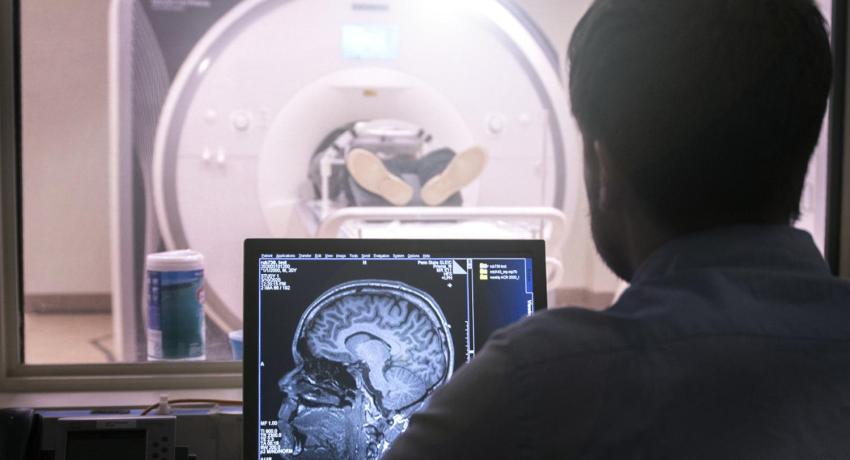A researcher works in the Thermoregulatory and Microvascular Research Laboratory. The Board of Trustees’ Committee on Academic Affairs, Research and Student Life recently heard a presentation on how the University plans to strengthen and expand its research enterprise. Credit: Patrick Mansell/Penn State. Creative Commons
Penn State achieved a record $1.03 billion in research expenditures in FY22 and is poised for continued growth as one of the nation’s top research institutions, Lora G. Weiss, senior vice president for research, told the Board of Trustees’ Committee on Academic Affairs, Research and Student Life on June 15. To build on recent successes, Weiss said, “will require a combination of strategic leadership, investments, partnering and positioning.”
She then led a panel discussion including faculty research leaders from across the University to present a vision of that future.
“Looking at annual research awards from FY19 to early 2023,” Weiss said, “we had hiring freezes, COVID, budget cuts, but even since that time we have seen a 25% increase in annual research awards. We need to invest in and grow our research operations in parallel with this growth in awards and expenditures. They go hand in hand.”
As a national leader in interdisciplinary research, she said, Penn State is a driver of progress impacting all aspects of society, from knowledge creation to economic development to national security.
“Our research enterprise attracts leading faculty to the University, provides career-building opportunities for students, attracts industry partnerships, is crucial to Penn State’s standing among the Association of American Universities, Big Ten Conference, and other world-class institutions, and serves as an important engine for state and local economies,” Weiss added.
The panel included Andrew Read, director of the Huck Institutes of the Life Sciences, Evan Pugh Professor of Biology and Entomology, and Eberly Professor of Biotechnology, .
Other panelists included Bruce Logan, director of the Institutes of Energy and the Environment, Evan Pugh University Professor, and Kappe Professor of Civil and Environmental Engineering; Cassie Mansfield, professor of art history and head of the Department of Art History; Martin Sliwinski, professor of human development and family studies and director of the Center for Healthy Aging; and Susan Trolier-McKinstry, Evan Pugh University Professor, Steward S. Flaschen Professor of Ceramic Science and Engineering, and professor of electrical engineering.
Strengths and opportunities
The single quality most responsible for Penn State’s research excellence, panelists agreed, is the culture that has flourished as a result of the creation of a unique research infrastructure over 30 years ago.
“The establishment of the Interdisciplinary research institutes and the sincere dedication to bringing people together across disciplinary boundaries make Penn State different,” said Trolier-McKinstry.
Sliwinski agreed. “The institutes, while not a secret weapon, are a tremendous, unique strength. In particular what I have seen is tremendous benefit from their autonomy and ability to make strategic investments. That just really has been game changing,” he said.
“We have a culture where people take pleasure in other people’s success,” said Read. “There are many research institutions where it’s dog-eat-dog, people are fighting for resources, fighting for recognition. Here, there’s a very strong spirit of collaboration.”
Read also cited Penn State’s strength in engineering as “seriously differentiating, allowing us in the life sciences to tackle problems which we couldn’t tackle otherwise. If we can bring the engineers together with the researchers in other areas some serious magic will happen,” he said.
Strengthening and expanding beyond the present level of success, Weiss said, will depend on:
-
Strategic leadership: Building on the unique infrastructure and culture of the interdisciplinary research institutes;
-
Strategic investments: In top faculty, staff and students; in seed grants that enable bold forays into new research directions and rapid response to emerging needs; and in world-class facilities and operations;
-
Strategic partnerships: With industry, sponsors, and donors; and
-
Strategic positioning: To drive the national conversation; to anticipate opportunities on the horizon, and to prepare Penn State students to be the next generation of leaders.
Sliwinski identified two trends — an aging population and climate change — whose growing intersection will present challenges and opportunities requiring an institution like Penn State to leverage its breadth of expertise to find solutions.
Because of that breadth and interdisciplinarity, Logan said, “Penn State is well-poised to address an overarching issue like climate [that] manifests itself in so many different ways – new materials, new technologies, new ways of growing crops, new ways of understanding mass migration and the political challenges that result. We have expertise in all these areas.”
Weiss closed the session with an anecdote. “I am regularly contacted by other institutions asking how we do interdisciplinary research,” she said. “We do it in a very unique way, by creating a budgetary approach where the money comes into the institutes and the institutes push the funds out to the colleges, instead of the reverse. We’ve been doing it that way for more than 30 years, and that has created a culture here that allows us to pursue interdisciplinary research in a very collaborative way.
“What we have is special.”

